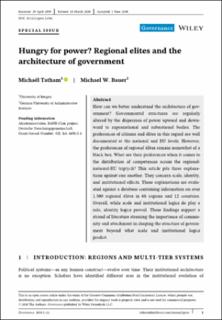Hungry for power? Regional elites and the architecture of government
Journal article, Peer reviewed
Published version

Åpne
Permanent lenke
https://hdl.handle.net/11250/2979608Utgivelsesdato
2021Metadata
Vis full innførselSamlinger
Sammendrag
How can we better understand the architecture of government? Governmental structures are regularly altered by the dispersion of power upward and downward to supranational and subnational bodies. The preferences of citizens and élites in this regard are well documented at the national and EU levels. However, the preferences of regional élites remain somewhat of a black box. What are their preferences when it comes to the distribution of competences across the regional-national-EU triptych? This article pits three explanations against one another. They concern scale, identity, and institutional effects. These explanations are evaluated against a database containing information on over 1,300 regional élites in 68 regions and 12 countries. Overall, while scale and institutional logics do play a role, identity logics prevail. These findings support a strand of literature stressing the importance of community and attachment in shaping the structure of government beyond what scale and institutional logics predict.
